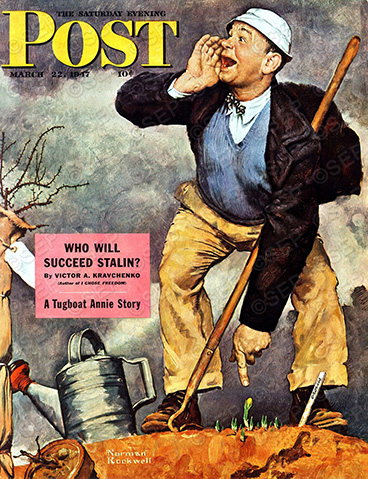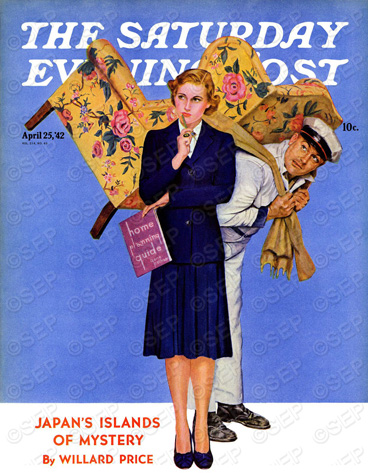An artist himself, Gene Pelham was Norman Rockwell’s photographer, prop–man, model wrangler, and much more.
First Flower
First Flower
Norman Rockwell
March 22, 1947
On a blustery March day a man excitedly spies that first crocus peeking through. The man is Gene Pelham, who as a youth had met Rockwell and occasionally modeled for him while living in New Rochelle, New York.
But in 1938, Marcy Kennedy Knight writes in the March/April 2013 issue of the Post, Pelham moved from New York, filled with visions of a country life. When settled, he dreamed of doing some farming in Arlington, Vermont. But a funny thing happened on the way to his dream. Knight writes that Pelham was in his yard one day when a man seeking directions pulled into his driveway and rolled down his window. Pelham looked up and “was amazed to see none other than Rockwell behind the wheel. ‘Norman? What are you doing here?’ he asked.”
What the artist was doing was moving to Arlington too. “Rockwell was delighted to find Pelham living in Arlington when he and his family arrived, and soon hired him as his studio assistant,” Ron Schick writes in Norman Rockwell: Behind the Camera. Pelham “built props, prepared canvases, wrangled models, and was himself a versatile and expressive model,” continues Schick. “The relationship was mutually beneficial: Pelham grew as an illustrator as he learned from his mentor, and Rockwell gained from Pelham’s considerable range of talents.”
Plumbers
Plumbers
Norman Rockwell
June 21, 1951
Plumbers was one of Rockwell’s most entertaining covers. Pelham (right) and Rockwell’s apprentice Don Winslow are typecast as Laurel and Hardy like characters cutting up in a fancy boudoir, much to the confusion of the Pekingese to the right. Rockwell’s passion for detail works a wonderful contrast between the room with it’s floral wallpaper and frilly vanity and the laborer with their dirty hands and well-used tools. There’s a good chance that Pelham was the one who located the tools. He was key to acquiring props for the artist.
“Dad never threw anything away,” Pelham’s daughter Melinda said in a recent Post interview. “Norman would get these things and say, ‘Here, Gene, take this. I don’t want it.’ I think that’s why he liked my dad so much because my dad could always come up with whatever it was he needed.”
Melinda has had fun over the years, looking at Rockwell’s paintings and recognizing various items. “A lot of the props he would drag from our house. Sometimes I see things in Post covers that are either things I had or someone in my family had.” For example, in Rockwell’s 1943 April Fool cover Melinda recognized the table (“it was my grandmother’s”), the chairs, and the clock that she still owns today.
A more famous prop was Rockwell’s chair, depicted in the cover Blank Canvas. After many years of use, the artist threw the chair out, but Pelham retrieved it and took it home. “Dad used it when he did his own painting,” from then on Melinda told us. And who wouldn’t? After all, America’s favorite illustrator created many iconic images while sitting in that old seat.
New Chair
New Chair
Gene Pelham
April 25, 1942
“My father was a landscape painter mostly,” Melinda says. “My mother used to say ‘You should paint more,’ but he didn’t.” Although he did a “few covers for the Post and Collier’s,” it was difficult to make a living at commercial illustration. The competition was great for magazine and advertisement art, and there was certainly no competing with Rockwell, who was at the pinnacle in these venues. Besides, Melinda says, “Norman kept him busy.”
By the time Pelham created this colorful 1942 cover, it was apparent that his move to Vermont’s countryside was the beginning of a trend. That February, the Post noted another of their illustrators, Mead Schaeffer, had “joined Norman Rockwell and Gene Pelham at Arlington, Vermont, in what promises to become a Post art colony.” They were prophetic words, for the tiny town would soon boast fellow cover artists John Atherton and George Hughes. These renowned illustrators socialized and consulted each other on their projects. We can see the influence of Hughes’ humorous everyday situations and Rockwell’s sense of fun in Pelham’s beleaguered moving man.
Become a Saturday Evening Post member and enjoy unlimited access. Subscribe now






